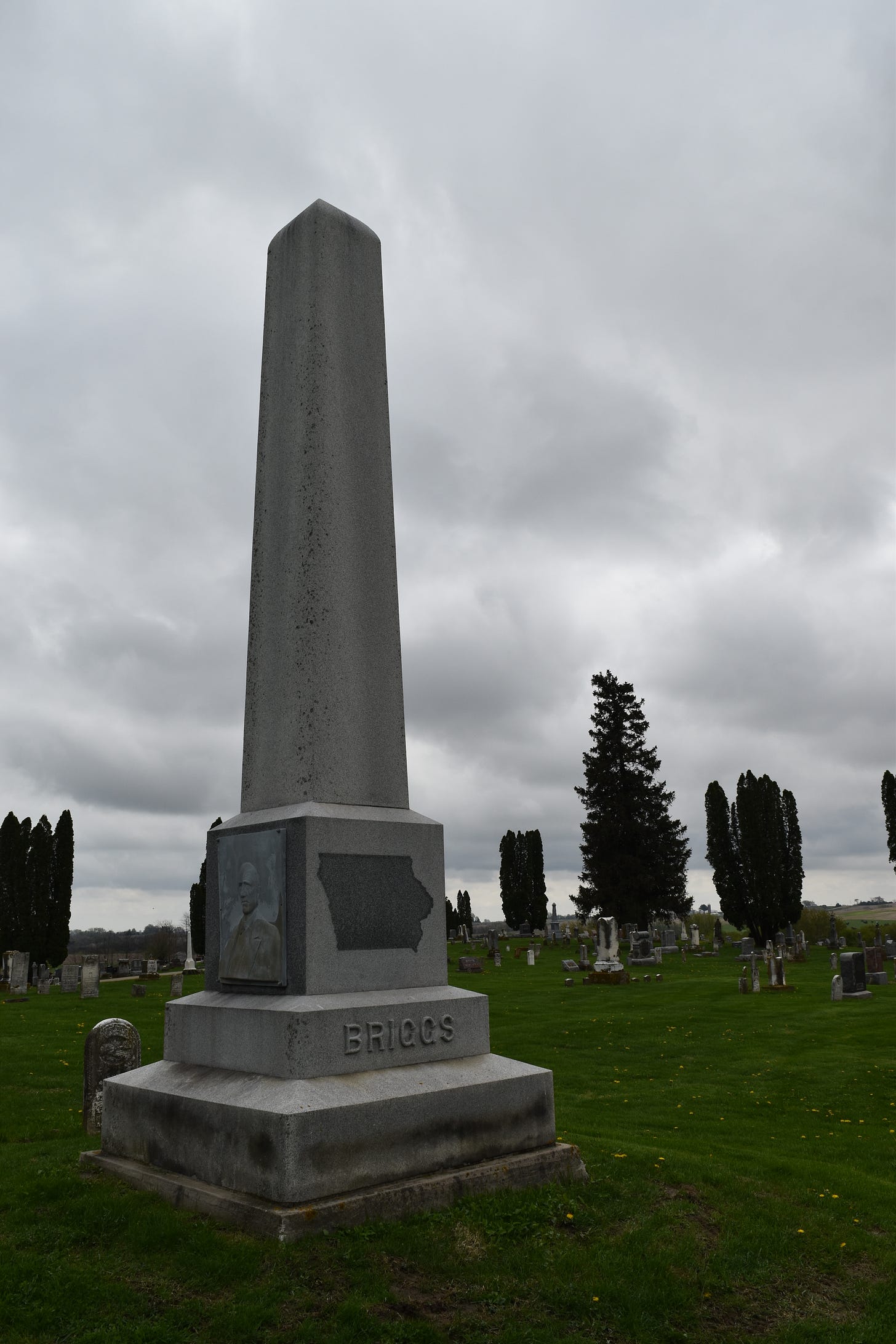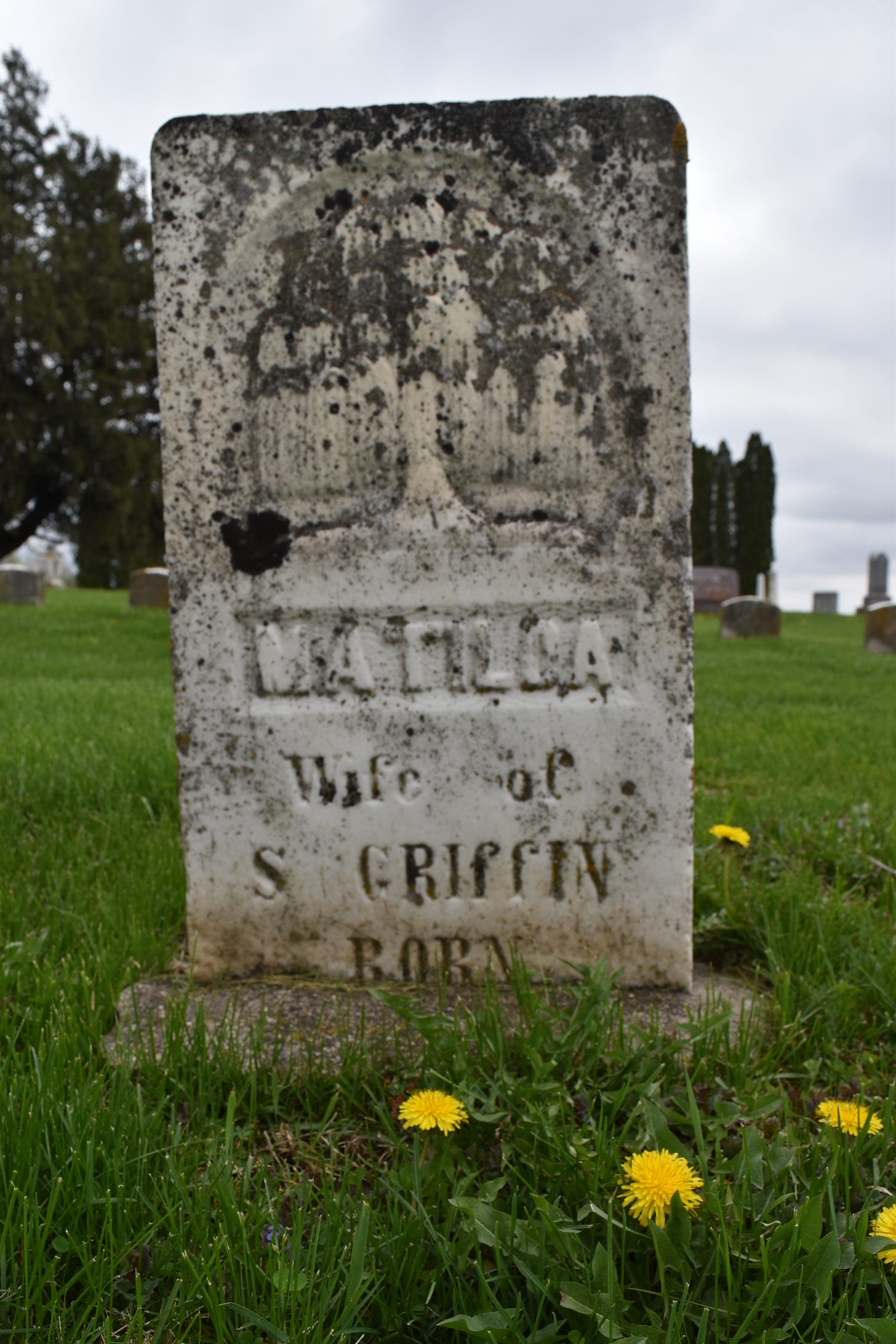My Civil War Ancestor Sylvester Griffin
A "barnstorming" farmer from Jackson county enlisted at age 61.
Sylvester Griffin’s tombstone in Andrew, Iowa. He was my third great-grandfather.
An obelisk for Ansel Briggs, Iowa’s first state governor. Griffin is buried nearby.
Matilda Austin Griffin, Sylvester’s wife and my third great-grandmother.
I've always been drawn to family history, and am grateful my immediate ancestors have preserved many records, photos and stories. Since retirement, one of my missions is to collect and share my family lore.
To begin with, I had five grandfathers that fought in the Civil War. Three were my second great-grandfathers:
--Francis Basquin, 5th Regiment, Ohio Infantry. He served during most of the war and his unit was in many major battles.
--John Olson, 33rd Regiment, Illinois Infantry. He enlisted shortly after his 14th birthday in early 1865.
--Azotus Grover, 31st Regiment, Iowa Infantry. He may have been the first white baby born in Jackson county, Iowa, in 1844.
Two were my third great-grandfathers:
--William McClenahan, a 1st Lt for the North Carolina 5th Regiment Cavalry. He hailed from Chatham county, NC. Yup, a Confederate.
--Sylvester Griffin, 12th Iowa Regiment, Infantry. He's today's subject.
Sylvester Griffin was a third great-grandfather on my Dad’s side. He led an adventurous and fascinating life.
According to the Jackson County, Iowa book Portrait and Biographical Album of 1889, Griffin was born in Vermont in 1800. His family moved to a New York farm in 1810. Sylvester trained as a shoemaker.
He married Matilda Austin, daughter of Peleg and Abiah Austin. I wrote about their relationship in a different essay.
In 1832, Sylvester Griffin bought a farm near Tiffin, Ohio. In 1843, he and his family moved to a farm in Perry Township, Jackson County, Iowa Territory (Iowa became a state in 1846).
As the Mexican American War started in 1846, Griffin (age 46) went to St Louis and enlisted, mustered into service under a “Captain Shields.” This may have been General James Shields (who nearly had a duel with Abraham Lincoln in 1842). Returning to Iowa with a souvenir sword, he continued farming.
Stricken with gold fever in 1851, Griffin set out on foot for California. Along the way, he worked briefly for Brigham Young in Salt Lake City. He stayed in California for about a year, working for several months on a Stockton cattle ranch. He returned “by way of Panama and New York” to his home in Iowa to continue farming.
When the Civil War broke out, Sylvester Griffin again enlisted for military service. Despite being 61 years old, he was mustered into service in Dubuque on November 25, 1861. According to the Roster and Records of Iowa Soldiers, War of the Rebellion, his hometown was listed as “Pennytown” in Jackson county. He joined Company K, one of ten companies organized as the 12th Iowa Infantry under the command of Col. J. J. Woods. They left “Camp Union, near Dubuque” by rail to St Louis a few days later for basic training at Benton Barracks.
In late January 1862, the regiment moved to Cairo, Illinois, where the Ohio river merged with the Mississippi. Steamers carried the troops up the Ohio to the mouth of the Cumberland River. They arrived at Fort Henry, Tennessee, shortly after a skirmish on Feb 6th secured the strategic river location for the Union. Several days later, the unit joined the battle at Fort Donelson, which resulted in another victory for Union troops. They remained there until March 6, 1862. Under the command of newly-appointed major general U. S. Grant, Griffin and Company K then boarded steamers and disembarked at Pittsburg Landing, Tennessee.
Nearby at a small church named Shiloh, rebel soldiers launched a surprise attack on April 6th. Union soldiers were pinned down that afternoon in an oak grove. Troops named it the Hornets’ Nest, saying the intense gunfire during the Battle of Shiloh sounded like angry hornets.
During the battle, Sylvester Griffin was shot through his left lung and hand. He was transported by steamboat to a hospital at Jefferson Barracks, south of St Louis, and died on May 26th, 1862.
About 65,000 Union and 45,000 Confederate troops fought at Shiloh. The Union suffered 13,047 casualties; Confederates sustained 10,669. Nearly one in four troops were either killed, injured, missing, or captured in only two days of battle. Estimated casualties for the Iowa 12th Regiment ranged from 479 to 513. The original number of regular troops mustered was 981.
More soldiers died at Shiloh in two days than had been killed in American military history up to that point. That includes various Indian battles, the American Revolution, the War of 1812, and the Mexican-American War.
Griffin is buried in Andrew, Iowa. His tombstone is located near the monument for Andrew native Ansel Briggs, Iowa's first state governor. Briggs had served as the executor for the humble estate of Griffin's son-in-law. Harvey Grover had died in a barn-raising accident in 1846. He had married Lucinda Griffin, Sylvester's daughter.
I'm humbled by the adventurous spirit and patriotic fervor of a man like Sylvester Griffin. Considering Civil War medical practices, I can't imagine how agonizing his last month must have been. How did he survive so long? W
Griffin was my only ancestor that died during the war. Others would suffer lifetime injuries. It’s still crazy to think he died from defending the Union at age 61.
We visited Andrew, Iowa, while camping at Maquoketa Caves state park in 2018. Driving the winding hilly roads, it's easy to see how Irish settlers thought Jackson county looked like home. Steady breezes stirred the May greenery.
Andrew had served as Jackson county seat in early days. A limestone county jailhouse was built there in 1870 and remains standing. South of the jail and behind a schoolhouse is the Andrew cemetery.
An impressive monument to Ansel Briggs towers over the tombstones. A short walk away, a GAR marker rose from the ground next to the graves of Sylvester Griffin and his wife Matilda. I stood in gratitude for his wartime service and in awe of Sylvester's wanderlust. I tried to imagine Matilda's long periods with an absent husband.
In the meantime, I need to get back to Jackson county and find Harvey Grover's burial site. He's the barn-raising casualty, my second great grandpa, and Sylvester's son-in-law.
Someday I hope to hear their stories.
Sources:
Portrait and Biographical Album of 1889, Jackson County IA; p 575-577.






